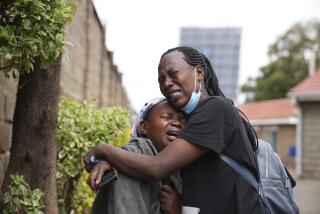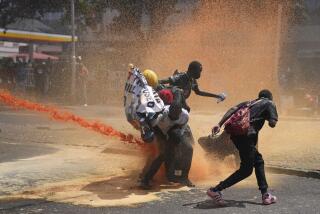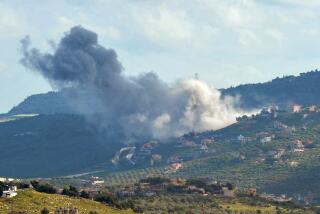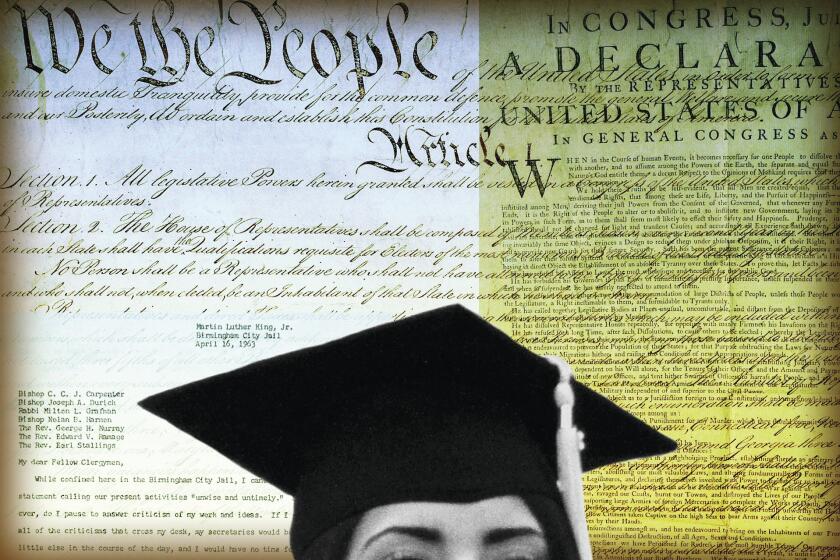Attacks in Kenya, Tanzania Kill 80, Hurt 1,700
NAIROBI, Kenya — Two powerful bomb blasts at U.S. embassies here and in neighboring Tanzania on Friday crumbled buildings, turned passing buses into bloody coffins and left rescue workers toiling into the early morning today in a frantic bid to free pleading survivors buried in the rubble.
At least 80 people, including eight Americans, were reported killed altogether, and more than 1,700 others were injured in what U.S. officials described as coordinated bombings by unknown terrorists. Although detailed information was still limited, senior officials concluded that attacks on two diplomatic facilities about 400 miles apart in less than five minutes of each other suggested a sophisticated terrorism operation.
Authorities in Kenya, where most of the casualties occurred, suspect that scores are still unaccounted for, although no one knows with certainty how many people were in the three buildings most devastated by the explosion. It may take days, they said, to track down missing people and remove all the bodies trapped in the debris.
“I just started running when I saw the flying glass and concrete hitting people, and the cars catching on fire,” said Susan Mutisya, who was standing across the street from the embassy in downtown Nairobi when the bomb exploded around 10:35 a.m. “Somehow I managed to get away.”
Almost simultaneously, an explosion in the parking lot of the U.S. Embassy in the Tanzanian capital of Dar es Salaam destroyed nearly two-thirds of the building. Rescue efforts there were reported continuing throughout this morning as well.
In Washington, President Clinton vowed to identify and prosecute the perpetrators. The United States dispatched military aircraft and personnel to Kenya and Tanzania to participate in the rescue effort, as well as a Marine Corps anti-terrorism unit, FBI investigators and explosive experts.
“These acts of terrorist violence are abhorrent; they are inhuman,” Clinton said during an appearance in the White House Rose Garden. “We will use all the means at our disposal to bring those responsible to justice, no matter what or how long it takes.”
The State Department said it had received no warning or claims of responsibility. Officials were not aware of any specific links between the bombings and any recent terrorist threats.
But, U.S. officials said, there is no doubt Americans were the target.
The two bombs were “aimed at killing and maiming as many as possible: Americans, Kenyans and Tanzanians,” Secretary of State Madeleine Albright said in Rome.
She was scheduled to return to Washington late Friday or early today to participate in the crisis response.
U.S. Creates Task Force
In Portugal, U.N. Secretary-General Kofi Annan called the attacks “indiscriminate” and “heartless” terrorism.
The United States immediately established an emergency task force at the State Department and launched its own investigation into the bombings.
“This appears to have been a very well-coordinated, very well-planned attack--clearly not the work of amateurs,” National Security Council spokesman P.J. Crowley said.
Kenyan rescue workers, using pickaxes, shovels and heavy earth-moving equipment, took their cues this morning from the muffled cries heard in a two-story-tall pile of twisted metal, concrete and office furniture that had been an office tower and secretarial college next to the embassy.
Red Cross officials said at least four people were still alive in an elevator submerged in tons of the debris, and two or three others could be heard from unseen caverns elsewhere.
Rescuers at the Scene
“We need a wire cutter!” a rescuer with a megaphone shouted from the hilltop of rubble, aglow with klieg lights.
“We need breathing oxygen!” came the next urgent request.
A crowd of onlookers, some awaiting word about missing family members, watched in stunned silence as rescuers worked to the solemn dirge of chugging generators and sputtering front-end loaders.
From time to time, the equipment was switched off and an eerie quiet took center stage.
“They stop and listen,” said Vincent Nicod, head of the International Red Cross delegation in Nairobi. “We have voice contact only. We can hear the screams.”
The six-story Ufundi Cooperative House building collapsed after a car bomb exploded in the driveway that separates it from the rear entrance to the U.S. Embassy, officials said. Witnesses said there were two explosions, with the second blast by far the most powerful.
The neighboring Cooperative Bank House, a 23-story high-rise, was also severely damaged, with people as high as the 15th floor being killed. Others on the sidewalk died when they were struck by falling glass from shattered windows.
U.S. Ambassador Prudence Bushnell and Kenyan Trade Minister Joseph Kamotho, who were meeting in the bank building just before the explosion, were among the injured, but officials said neither was seriously hurt.
Kenyan media reported that scores of people, some masquerading as medical workers, were arrested in and around the bank building for rummaging through the pockets and handbags of the dead and looting shops.
The massive concrete U.S. Embassy building was also gutted, and its 10-inch-thick walls blasted open in spots, but it remained standing. A pair of supposedly bomb-proof doors were ripped off the building and later used as makeshift stretchers to ferry the injured to ambulances, Kenyan authorities said.
“I heard the blast as I stepped out of the embassy building,” said a woman who identified herself only as Rose, who had just finished giving a Swahili lesson to an American official. “I ran for my life.”
By early this morning, rescue efforts at the embassy were over, the dead reportedly piled behind barbed wire in a second-floor room.
Red Cross officials said the Americans were awaiting the arrival of the U.S. medical and investigative teams before removing the dead. U.S. officials reported five Americans were still missing this morning, and at least one of the American casualties was a child. The Pentagon said late Friday that Sgt. Kenneth Hobson, 27, of Nevada, Mo., was among the dead. He was an administrative specialist working with the U.S. defense attache.
At the embassy in Dar es Salaam, officials said none of the six people killed were Americans.
Searching for Answers
“I was camped out in front of the embassy from 11 a.m. to 4 p.m., but they won’t tell me anything,” said Kazim Butt, whose brother-in-law works as a cashier at the embassy in Nairobi. “He works right there, right where the damn thing went off.”
Butt and a friend combed the emergency wards of 10 hospitals, they said, but could not find Farhap Sheikh, the missing father of four. A nurse outside the embassy told them to prepare Sheikh’s wife for the worse.
“But we haven’t said anything to his wife . . . not until we see his body,” Butt said.
Kenyan television reported that witnesses saw suspicious characters loitering around the U.S. Embassy just minutes before the blast. Red Cross volunteer Evelyn Myaboke, who arrived at the scene just after the explosion, corroborated the report early this morning. She said some of the injured told rescue workers that four men who appeared to be Arabs had scuffled with security guards at the entrance to the embassy’s basement parking garage.
According to the witness accounts, Myaboke said, the four tried to enter the garage in two cars but were turned away by the guards. The men then parked the cars in the alley, shot at the guards and fled. Two of the men were apparently killed in the blast, Myaboke said, while the other two ran away on foot.
There was no official confirmation of the witness reports.
“What we Kenyans can’t understand is, if they were targeting the Americans, why not do it in the United States instead of killing our people?” asked Myaboke, who was still wearing white surgical gloves early this morning, even though she had long stepped back from the rescue effort. “It fills me with both anger and sadness.”
Inquiry Is Launched
The FBI and all major wings of the U.S. intelligence community began scrambling to determine who might be responsible for the attacks, which occurred in seemingly unlikely locales.
Criminal investigators and counter-terrorism experts were deployed from Washington. The FBI usually takes the lead in on-site investigations, as it did in the 1983 and 1984 embassy bombings in Lebanon and the 1996 bombing of a military compound in Saudi Arabia.
Undersecretary of State Thomas R. Pickering said at a news briefing that the bombings did not reflect any failure of U.S. intelligence.
“We have a top-class intelligence community that works extremely hard, that examines a huge amount of information. That doesn’t mean you catch every incident, especially when people work hard to prevent you from finding out,” he said.
Pickering warned against expecting any fast breaks in the case. But he also said the United States would not be discussing leads or evidence in public until a formal investigation is finished.
“Law enforcement and intelligence items are the kind of subjects we don’t talk about . . . until we have some conclusion,” he said.
Several senior Clinton administration officials expressed confidence that the perpetrators ultimately would be identified, even though some past bombings remain unresolved and others were not prosecuted until many years after the fact.
Among them are the 1983 and 1984 embassy bombings in Lebanon, which killed dozens of Americans; the 1983 Marine barracks bombing in Lebanon, which was the largest non-nuclear blast since World War II and killed 241; and the 1996 Khobar bombing of a U.S. military compound in Saudi Arabia that killed 19.
“We have a long series of cases, some many years old, which I’m happy to say have been brought to fruition in recent years. So I don’t believe that anyone should assume that the U.S. government will ever give up on these cases or that, in fact, the failure to make immediate progress in some is an indication, somehow, that we are not going to bring . . . people to justice wherever they may be,” Pickering said.
The two American missions in East Africa were particularly vulnerable, U.S. officials conceded. Neither met new security standards imposed after the embassy attacks in Lebanon in the 1980s. In addition, the Nairobi embassy is located in the middle of a downtown area and is therefore difficult to cordon off or distance from the street to offer adequate protection from car bombs.
House Speaker Newt Gingrich (R-Ga.) told reporters that congressional leaders intend to work very closely with Clinton in formulating a U.S. response and expressed confidence that the president is “totally focused” on the crisis.
“The president is doing his job,” Gingrich said.
Rep. Benjamin A. Gilman (R-N.Y.), chairman of the House International Relations Committee, said the bombings “underscore the truism that our diplomatic corps, in this day and age, is as much on the front line as any of our military personnel.”
Hearings Planned
Gilman said his committee will conduct hearings on the terrorist threat to U.S. facilities overseas when Congress returns from its August recess next month.
“The bombing attacks on our American embassies in Kenya and Tanzania are outrageous criminal attacks and must be treated that way. And it underscores the need for beefing up security in all of our embassies; and we haven’t done enough, regrettably, in our African embassies,” he said.
“Any attack on an American Embassy is an attack on our nation,” Gilman added.
Murphy reported from Nairobi, Kenya, and Wright from Washington. Joyce Ilako of The Times’ Nairobi Bureau contributed to this report.
(BEGIN TEXT OF INFOBOX / INFOGRAPHIC)
Nairobi Bomb Attack
A car bomb attack in the Kenyan capital of Nairobi leveled the Ufundi House next to the U.S. Embassy. At least 74 people died and 1,643 were injured in the bombing.
COOPERATIVE BANK HOUSE: Undetermined number of people inside and outside bank were reported killed and hundreds injured. Prudence Bushnell, U.S. ambassador to Kenya, was cut on the lip after delivering news conference. Bomb destroyed face of building.
UFUNDI HOUSE: Caved in by blast. Home to small businesses and secretarial college. Unknown number of people were killed.
U.S. EMBASSY: At least eight Americans killed.
Passengers in a bus were incinerated in their seats.
Bomb planted in a Mitsubishi Pajero car parked in alley.
****
“Bombproof is a relative term. Tell me what size bomb, and I’ll tell you what the proof is.”
-Thomas R. Pickering, undersecretary of State for political affairs
More to Read
Sign up for Essential California
The most important California stories and recommendations in your inbox every morning.
You may occasionally receive promotional content from the Los Angeles Times.










